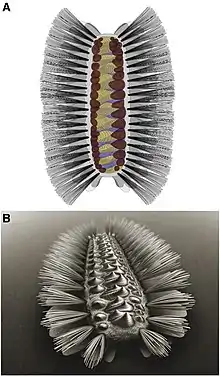Camenellan
The camenellans, consisting of the genera Camenalla, Dailyatia, Kennardia, Kelanella, Wufengella and Lapworthella, are a (probably monophyletic) group of Tommotiid invertebrates from the Cambrian period, reconstructed as sister to all others (plus brachiopods and phoronids). They are primarily known from isolated sclerites, but are believed to have a scleritomous, Halkieria-like construction.[2][3] This was confirmed by the discovery of Wufengella, known from articulated remains, which showed camenellans to be mobile, worm-like animals.[4]
| Camenellan Temporal range: | |
|---|---|
 | |
| Reconstruction and life restoration of the camenellan Wufengella | |
| Scientific classification | |
| Domain: | Eukaryota |
| Kingdom: | Animalia |
| Order: | †"Tommotiida" |
| Informal group: | †Camenellans |
| Genera | |
| |

Dailyatia and Camenella have distinct dorsal (symmetrical) and lateral (asymmetric) sclerite morphologies. The same has been asserted for Lapworthella[5] even though that has not always been the common perception.[3]
It has been argued that Camenella, Kelanella and Lapworthella, assuming a slug-like anatomy, had an anterior 'head valve' followed by pairs of asymmetric valves running in pairs along their dorsal surface.[5]
The 'head valve' in Lapworthella - that is the bilaterally symmetric Morph A valve - is thought to have fused from two ontogenetically separate sclerites.[5] Dailyatia has a similar double-mounded structure at the tip of its A type sclerites.[2]
Growth rings in all are marked out by prominent external ridges.[2][5]
Taxonomy
Two families:[2]
Kennardiidae Laurie, 1986: three sclerite morphs, one of which (conventionally termed the A morph) is bilaterally symmetrical, the other two occurring in sinistral and dextral variants. Includes Kennardia and Dailyatia, and questionably Shetlandia
Lapworthellidae: sclerites occur in something of a morphological continuum, but essentially form a single type with a sinistral and dextral version, possibly with the anterior-most pair of sclerites fusing into a single bilaterally-symmetrical, dual-tipped sclerite.
Dailyatia species:[2]
- D. ajax Bischoff, 1976 (type)
- D. bacata Skovsted et al., 2015
- D. braddocki Evans & Rowell, 1990
- D. decobruta Betts, 2019[6]
- D. helica Skovsted et al., 2015
- D. macroptera (Tate, 1892)
- D. odyssei Evans & Rowell, 1990
References
- Devaere, L. et al. The tommotiid Kelanella and associated fauna from the early Cambrian of southern Montagne Noire (France): implications for camenellan phylogeny. Palaeontology 57, 979–1002 (2014).
- Skovsted, C. B., Betts, M. J., Topper, T. P. & Brock, G. A. The early Cambrian tommotiid genus Dailyatia from South Australia. Mem. Assoc. Australas. Palaeontol. 48, 1–117 (2015).
- Murdock, D. J. E., Donoghue, P. C. J., Bengtson, S. & Marone, F. Ontogeny and micro-structure of the enigmatic Cambrian tommotiid Sunnaginia Missarzhevsky, 1969. Palaeontology 55, 661–676 (2012).
- Guo, Jin; Parry, Luke A.; Vinther, Jakob; Edgecombe, Gregory D.; Wei, Fan; Zhao, Jun; Zhao, Yang; Béthoux, Olivier; Lei, Xiangtong; Chen, Ailin; Hou, Xianguang; Chen, Taimin; Cong, Peiyun (2022). "A Cambrian tommotiid preserving soft tissues reveals the metameric ancestry of lophophorates". Current Biology. Online: S0960–9822(22)01455–5. doi:10.1016/j.cub.2022.09.011. ISSN 1879-0445. PMID 36170853.
- Devaere, L. & Skovsted, C. B. New early Cambrian sclerites of Lapworthella schodakensis from NE Greenland: advancements in knowledge of lapworthellid taxonomy, sclerite growth and scleritome organization. Geol. Mag. (2016). doi:10.1017/S0016756816000698
- Betts, Marissa; Claybourn, Thomas; Brock, Glenn; Jago, James; Skovsted, Christian; Paterson, John (2019). "Early Cambrian shelly fossils from the White Point Conglomerate, Kangaroo Island, South Australia" (PDF). Acta Palaeontologica Polonica. 64 (3). doi:10.4202/app.00586.2018.